1. Bergeron MF, Bahr R, Bärtsch P, Bourdon L, Calbet JA, Carlsen KH, et al. International Olympic Committee consensus statement on thermoregulatory and altitude challenges for high-level athletes. Br J Sports Med. 2012; 46:770–779. PMID:
22685119.

2. Carlsen KH. Sports in extreme conditions: the impact of exercise in cold temperatures on asthma and bronchial hyper-responsiveness in athletes. Br J Sports Med. 2012; 46:796–799. PMID:
22906782.

3. Koskela HO. Cold air-provoked respiratory symptoms: the mechanisms and management. Int J Circumpolar Health. 2007; 66:91–100. PMID:
17515249.

4. Quirion A, Laurencelle L, Paulin L, Therminarias A, Brisson GR, Audet A, et al. Metabolic and hormonal responses during exercise at 20 degrees, 0 degrees and -20 degrees C. Int J Biometeorol. 1989; 33:227–232. PMID:
2613366.
5. Larsson K, Tornling G, Gavhed D, Müller-Suur C, Palmberg L. Inhalation of cold air increases the number of inflammatory cells in the lungs in healthy subjects. Eur Respir J. 1998; 12:825–830. PMID:
9817153.

6. Stensrud T, Berntsen S, Carlsen KH. Exercise capacity and exercise-induced bronchoconstriction (EIB) in a cold environment. Respir Med. 2007; 101:1529–1536. PMID:
17317135.

7. Stensrud T, Mykland KV, Gabrielsen K, Carlsen KH. Bronchial hyperresponsiveness in skiers: field test versus methacholine provocation? Med Sci Sports Exerc. 2007; 39:1681–1686. PMID:
17909392.
8. Parsons JP, Kaeding C, Phillips G, Jarjoura D, Wadley G, Mastronarde JG. Prevalence of exercise-induced bronchospasm in a cohort of varsity college athletes. Med Sci Sports Exerc. 2007; 39:1487–1492. PMID:
17805078.

9. Strauss RH, McFadden ER Jr, Ingram RH Jr, Jaeger JJ, Stearns DR. Enhancement of exercise-induced asthma by cold air. N Engl J Med. 1977; 297:743–747. PMID:
895804.

10. Anderson SD, Daviskas E. The mechanism of exercise-induced asthma is …. J Allergy Clin Immunol. 2000; 106:453–459. PMID:
10984363.

11. Turmel J, Bougault V, Boulet LP. Seasonal variations of cough reflex sensitivity in elite athletes training in cold air environment. Cough. 2012; 8:2. PMID:
22449054.

12. Bougault V, Turmel J, Boulet LP. Bronchial challenges and respiratory symptoms in elite swimmers and winter sport athletes: airway hyperresponsiveness in asthma: its measurement and clinical significance. Chest. 2010; 138:31S–37S. PMID:
20363843.
13. Eichner ER. Asthma in athletes: scope, risks, mimics, trends. Curr Sports Med Rep. 2008; 7:118–119. PMID:
18477865.
14. Rundell KW, Im J, Mayers LB, Wilber RL, Szmedra L, Schmitz HR. Self-reported symptoms and exercise-induced asthma in the elite athlete. Med Sci Sports Exerc. 2001; 33:208–213. PMID:
11224807.

15. Rundell KW, Wilber RL, Szmedra L, Jenkinson DM, Mayers LB, Im J. Exercise-induced asthma screening of elite athletes: field versus laboratory exercise challenge. Med Sci Sports Exerc. 2000; 32:309–316. PMID:
10694112.

16. Langdeau JB, Day A, Turcotte H, Boulet LP. Gender differences in the prevalence of airway hyperresponsiveness and asthma in athletes. Respir Med. 2009; 103:401–406. PMID:
19027280.

17. McClaran SR, Harms CA, Pegelow DF, Dempsey JA. Smaller lungs in women affect exercise hyperpnea. J Appl Physiol (1985). 1998; 84:1872–1881. PMID:
9609779.

18. Miller MR, Hankinson J, Brusasco V, Burgos F, Casaburi R, Coates A, et al. Standardisation of spirometry. Eur Respir J. 2005; 26:319–338. PMID:
16055882.
19. Borg GA. Psychophysical bases of perceived exertion. Med Sci Sports Exerc. 1982; 14:377–381. PMID:
7154893.

20. Stensrud T, Carlsen KH. Can one single test protocol for provoking exercise-induced bronchoconstriction also be used for assessing aerobic capacity? Clin Respir J. 2008; 2:47–53. PMID:
20298304.

21. Castellani JW, Young AJ, Ducharme MB, Giesbrecht GG, Glickman E, Sallis RE, et al. American College of Sports Medicine position stand: prevention of cold injuries during exercise. Med Sci Sports Exerc. 2006; 38:2012–2029. PMID:
17095937.
22. Heir T, Oseid S. Self-reported asthma and exercise-induced asthma symptoms in high-level competitive cross-country skiers. Scand J Med Sci Sports. 1994; 4:128–133.

23. Herman L, Foster C, Maher MA, Mikat RP, Porcari JP. Validity and reliability of the session RPE method for monitoring exercise training intensity. South Afr J Sports Med. 2006; 18:14–17.

24. Pellegrino R, Viegi G, Brusasco V, Crapo RO, Burgos F, Casaburi R, et al. Interpretative strategies for lung function tests. Eur Respir J. 2005; 26:948–968. PMID:
16264058.
25. Rundell KW, Slee JB. Exercise and other indirect challenges to demonstrate asthma or exercise-induced bronchoconstriction in athletes. J Allergy Clin Immunol. 2008; 122:238–246. PMID:
18678339.

26. Holzer K, Brukner P. Screening of athletes for exercise-induced bronchoconstriction. Clin J Sport Med. 2004; 14:134–138. PMID:
15166901.

27. Cappaert TA, Stone JA, Castellani JW, Krause BA, Smith D, Stephens BA, et al. National Athletic Trainers' Association position statement: environmental cold injuries. J Athl Train. 2008; 43:640–658. PMID:
19030143.

28. Evans TM, Rundell KW, Beck KC, Levine AM, Baumann JM. Airway narrowing measured by spirometry and impulse oscillometry following room temperature and cold temperature exercise. Chest. 2005; 128:2412–2419. PMID:
16236903.

29. Farley RD, Albazzaz MK, Patel KR. Role of cooling and drying in hyperventilation induced asthma. Thorax. 1988; 43:289–294. PMID:
3406916.

30. Helenius IJ, Tikkanen HO, Sarna S, Haahtela T. Asthma and increased bronchial responsiveness in elite athletes: atopy and sport event as risk factors. J Allergy Clin Immunol. 1998; 101:646–652. PMID:
9600502.
31. Rundell KW, Spiering BA, Baumann JM, Evans TM. Effects of montelukast on airway narrowing from eucapnic voluntary hyperventilation and cold air exercise. Br J Sports Med. 2005; 39:232–236. PMID:
15793094.

32. Stensrud T, Berntsen S, Carlsen KH. Humidity influences exercise capacity in subjects with exercise-induced bronchoconstriction (EIB). Respir Med. 2006; 100:1633–1641. PMID:
16446080.

33. Cole P. Further observations on the conditioning of respiratory air. J Laryngol Otol. 1953; 67:669–681. PMID:
13109356.

34. Carlsen KH, Engh G, Mørk M. Exercise-induced bronchoconstriction depends on exercise load. Respir Med. 2000; 94:750–755. PMID:
10955749.

35. McFadden ER Jr, Lenner KA, Strohl KP. Postexertional airway rewarming and thermally induced asthma. New insights into pathophysiology and possible pathogenesis. J Clin Invest. 1986; 78:18–25. PMID:
3722374.

36. Kippelen P, Anderson SD. Airway injury during high-level exercise. Br J Sports Med. 2012; 46:385–390. PMID:
22247295.

37. McFadden ER Jr, Pichurko BM, Bowman HF, Ingenito E, Burns S, Dowling N, et al. Thermal mapping of the airways in humans. J Appl Physiol (1985). 1985; 58:564–570. PMID:
3980358.

38. Parsons JP, Mastronarde JG. Exercise-induced bronchoconstriction in athletes. Chest. 2005; 128:3966–3974. PMID:
16354868.

39. Sylta Ø, Tønnessen E, Seiler S. Do elite endurance athletes report their training accurately? Int J Sports Physiol Perform. 2014; 9:85–92. PMID:
23921186.

40. Esteve-Lanao J, San Juan AF, Earnest CP, Foster C, Lucia A. How do endurance runners actually train? Relationship with competition performance. Med Sci Sports Exerc. 2005; 37:496–504. PMID:
15741850.

41. Stocks JM, Taylor NA, Tipton MJ, Greenleaf JE. Human physiological responses to cold exposure. Aviat Space Environ Med. 2004; 75:444–457. PMID:
15152898.
42. Raven PB, Niki I, Dahms TE, Horvath SM. Compensatory cardiovascular responses during an environmental cold stress, 5 degrees C. J Appl Physiol. 1970; 29:417–421. PMID:
5459907.

43. Sandsund M, Faerevik H, Reinertsen RE, Bjermer L. Effects of breathing cold and warm air on lung function and physical performance in asthmatic and nonasthmatic athletes during exercise in the cold. Ann N Y Acad Sci. 1997; 813:751–756. PMID:
9100966.

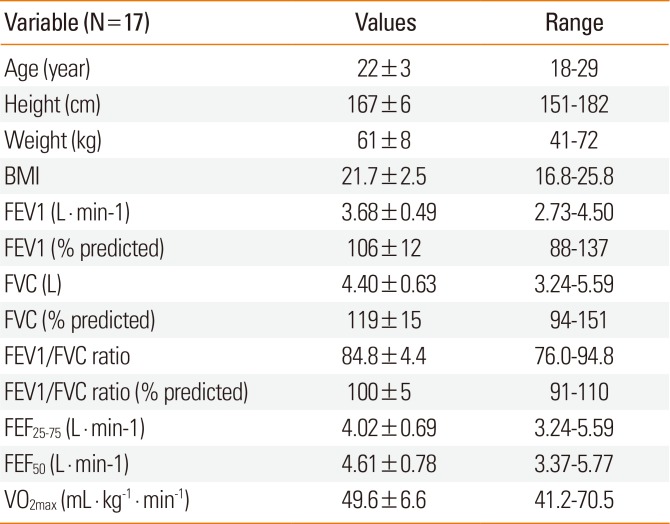
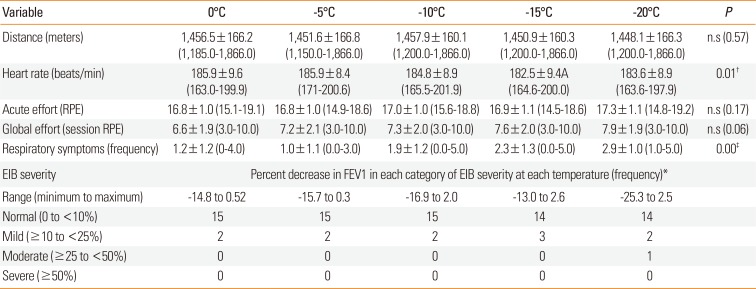
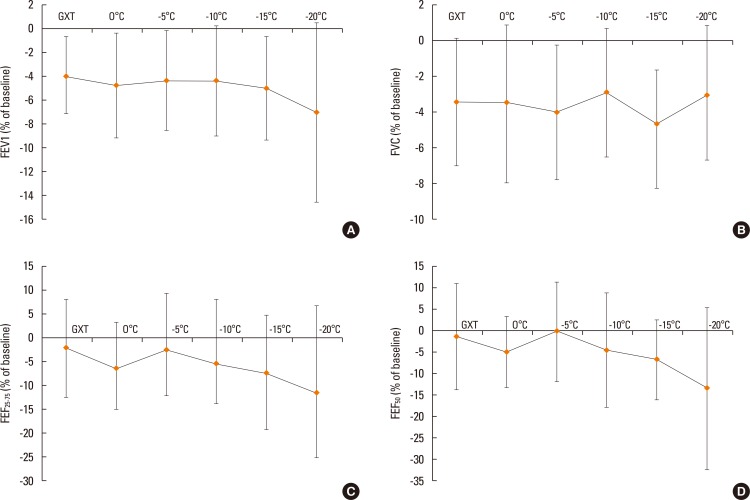
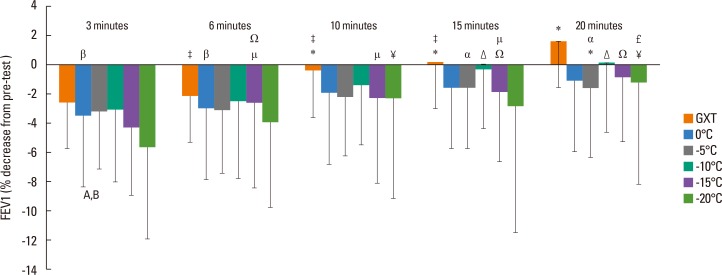
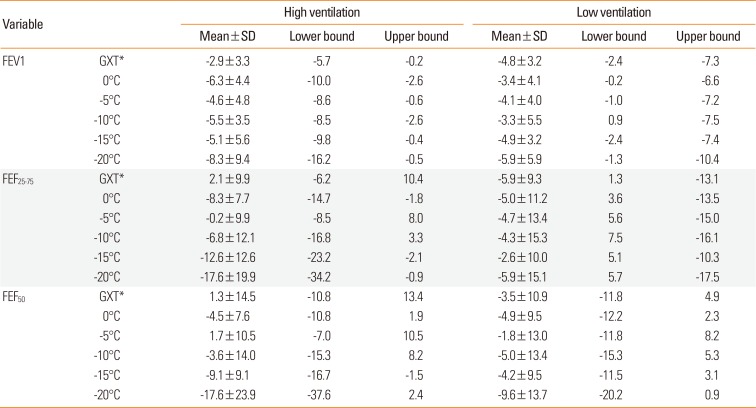




 PDF
PDF ePub
ePub Citation
Citation Print
Print


 XML Download
XML Download